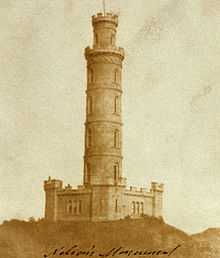Thomas Bonnar
Thomas Bonnar ( d.1847) was a Scottish interior designer and architect of note, working in the Edinburgh area. He is particularly remembered for his outstanding ceilings.
Thomas was father to William Bonnar RSA (1800-1853), artist, and Thomas Bonnar (1810-1873) engraver, who collaborated with William on several works.
The group are also known by the family company name of Bonnar & Co.
Life
He was born in Edinburgh around 1770, the son of John Bonnar who had created the ceilings in Penicuik House.[1]
He was appointed as a burgess of the city in 1795 and a “sworn measurer” in 1807 and Superintendent of Works for the city in 1809, operating from the Magdalene Chapel in the Cowgate. From 1810 he acted as architect and surveyor to George Heriot’s School. He lost all public posts in January 1819 due to a bungled execution on 30 December (part of his wide scope of duties) which ended in a public riot.
A house at 7 Ann Street is known as “Thomas Bonnar’s House” but there is no record of his living there, but he IS responsible for its fine interior decoration.[2] He did many fine and many unique interiors, including St Bernard’s Well at Stockbridge
He retired in 1832 and died in 1847.
George Heriot's School replaced him with Alexander Black in 1833.[3]
His daughter Elizabeth married George Meikle Kemp.
Works

_Dean_Cemetery.jpg)
- Completion of Robert Burn's Nelson’s Monument on Calton Hill (1814-1816)
- Original layout of New Calton Burial Ground (1816-1817), completed by Thomas Brown)
- Completion of Drummond Place (1816-1817)
- 1 to 13 Hermitage Place, Leith (1817-1825)
- Gardener’s House, Queen Street Gardens (1819) demolished
- Bellevue Crescent (1819-1832) southern half only - northern half unbuilt until 1880s.
- 4-15 Gloucester Place (1822-1824)
- 42-54 London Street (1823)
- 1-85 East Claremont Street (1824)
- Atholl Crescent, Atholl Place and the north side of Torphichen Street (1824-1826)
- Bellevue Terrace (1825) building works overseen by Alexander Black, northern section never built
Thomas Bonnar (the younger)
Thomas Bonnar the younger was born in Edinburgh in 1810. He followed in his father’s footsteps as an interior designer and artist but did not venture into architecture.
He died in 1873 and is buried with his wife Mary Thom (1813-1858) in a crowded section of Dean Cemetery east of the new Dean Gallery entrance and north-east of the distinctive pyramid therein with a strange back-to-back monument with his son Thomas (1838-1896), designed by David Watson Stevenson. His sons, William Dundas Bonnar, engraver (1831-1855) and Thomas Bonnar (d.1899) are buried with them.
His interiors include:[4]
- Drawing-room, Newbattle Abbey
- Drawing-room, Mortonhall House
- Office interior for Thomas Nelson (publisher) in Paternoster Row, London
- Ceilings for Thomas Nelson (publisher) in his Edinburgh home, St. Leonard’s
Thomas in turn also had a son named Thomas (1838-1896) operational largely in the 1890s and responsible for some ceilings at Falkland Palace and Liberton House[5] and Riddles Court on the Lawnmarket.[6]
References
- ↑ Dictionary of Scottish Architects: George Meikle Kemp
- ↑ "Item Details for Edinburgh, 7 Ann Street, interior. View of parlour in Thomas Bonnar's house.".
- ↑ Dictionary of Scottish Architects: Black
- ↑ "Overview of Thomas Bonnar".
- ↑ "Edinburgh, Liberton Drive, Liberton House".
- ↑ http://www.shbt.org.uk/files/9813/4209/7733/Riddles_Court_Project_Sheet.pdf
External links
- http://nevinofedinburgh.co.uk/mortonhall-house,-edinburgh.html
- http://www.scottish-places.info/scotgaz/features/featurefirst3888.html
- http://www.scran.ac.uk/database/record.php?usi=000-000-583-953-C&scache=3zuzbtd6cl&searchdb=scran